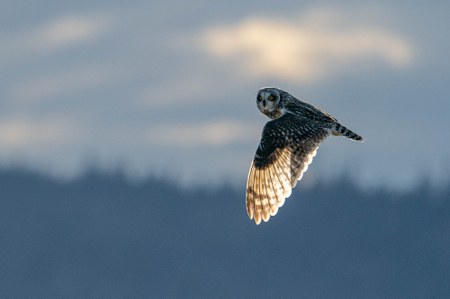
"Look there!" Danielle pointed across the marsh to the west, her binoculars just below her eyes.
"What do you see?" John quickly lifted his binoculars.
I snapped mine up and began to scan the marsh, as Donna exclaimed, "Maybe it's a Short-eared Owl." The bird was just a speck, probably more than a quarter-mile away.
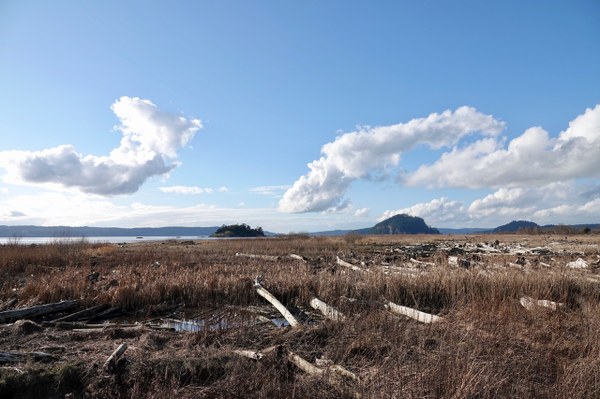 The marshes along the edge of Skagit Bay. This is good wintering habitat for Short-eared Owls and Northern Harriers. Photo by Donna Hahn.
The marshes along the edge of Skagit Bay. This is good wintering habitat for Short-eared Owls and Northern Harriers. Photo by Donna Hahn.
To me, these owls seem more crepuscular here in Washington and shouldn't be flying at 2 o'clock on a February afternoon. But sure enough, this bird had the slow wing beats typical of that species - a buoyant flight, almost too slow it seemed for it to stay aloft. As it twisted one way or another, it looked more like a giant moth than a flying bird. "Yes, definitely a Short-eared Owl," I said.
"Look how it just floats along," Danielle had her binoculars back to her eyes.
"They are so wonderful to watch. I had some up at Samish Flats a few weeks ago," Donna added.
These owls always seem so soft and delicate as they fly back and forth, almost as if they aren't real. I'd hoped we might find one but hadn't expected it here.
Our group had spread out along the dike. This was the twelfth month since the coronavirus had surged across Washington State and maintaining social distances remained critical. We'd come in separate cars, birding our way along the Stillaguamish River and now Fir Island, stopping at all my favorite places. I was leading my first car-based birding trip for The Mountaineers since the pandemic began a year ago. Typically, I'd have conducted several trips each month and weekly in the summer, but those had been put on hold with the coronavirus threat. This was an experiment to see if we could bird and maintain our distance enough to remain safe. Pre-pandemic, we'd have all come in one car and been able to chat along the way. We did have walkie-talkies, so we could communicate while driving, but those were truncated announcements, like "a Bald Eagle in the tree on the left." Going in separate cars seemed like an extravagance - too much carbon - but I'd been longing to lead a trip for several months. Perhaps, it was not just the birds I wanted to see, but the human companionship, as well.
John, Donna, and I had instructed with a moss and lichen class two weeks earlier, building some confidence that we could safely conduct field trips. We'd initially met on a large lawn for the moss class where the main instructor could go over logistics. Then each instructor helped two or three participants find mosses on the trails. I could point things out with a small group, stepping back to allow each person a solo look. I'd posted this birding trip soon after that course.
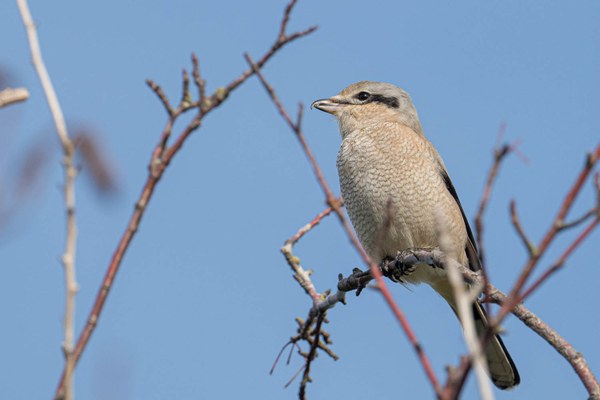 A Northern Shrike pauses in a bush as it searches the marshes for possible prey.
A Northern Shrike pauses in a bush as it searches the marshes for possible prey.
I brought a spotting scope on this birding trip and antiseptic wipes to clean it regularly. It seemed to work well. I'd put the scope on a bird, then back away ten or twelve feet, and the others, one at a time, could look through it and get a better view of a distant bird. Right then, I had it set up on the dike and was scanning the wetlands to the south. When we parked on Rawlins Road, a Northern Shrike had flown in that direction. In some winters, this species comes down from Canada or Alaska to spend the cold months here. There was no longer a sign of the shrike, but a Northern Harrier flew low over the southern marsh, its wings held in that typical dihedral pattern. The long brown tail with the white rump patch was an excellent identifying characteristic, too. This hawk feeds on the same prey - small rodents - as the Short-eared Owl. Sometimes these two species will chase each other, trying to scare the other away from prime feeding areas. Right then, they were far apart, and each was quartering back and forth, not appearing to notice the other.
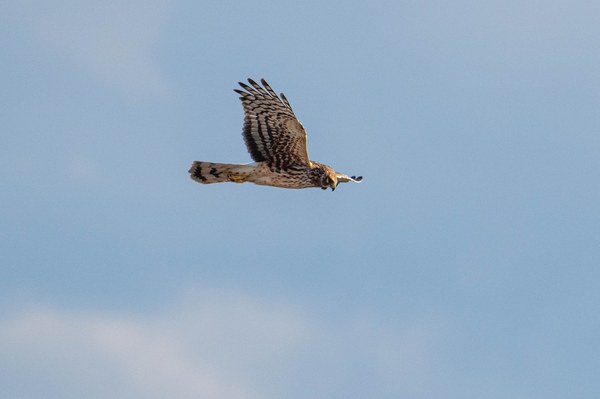 A Northern Harrier quarters back and forth over the marsh looking for voles or mice.
A Northern Harrier quarters back and forth over the marsh looking for voles or mice.
During the winter, harriers and owls live solitary lives. Perhaps they don't find this problematic. But for me, this past year of isolation had been particularly long and grueling. I live by myself, and only occasionally could I meet with friends for walks, and maintaining appropriate distances remained critical. No hugs or even handshakes. Sometimes when I went for groceries, I'd wait to go through the regular check out instead of the express lane so that I'd have a few minutes to talk with someone. As I followed my fellow Mountaineers along the dike, I realized how nice this trip together had been, even if we couldn't carpool. Leading trips was more than just sharing my love of nature; it was about enjoying nature with friends, seeing what they got excited about, and sharing those mutual experiences as well as our lives.
A female Spotted Towhee flitted into a bush. I'd made a squeaking sound through my lips, and sure enough, she showed up. My companions delighted in her sudden appearance. Her rufous flanks contrasted with her dark brownish-black back. Her long tail twitched back and forth. I'd disturbed her, and I wondered if that was where my feelings of isolation and loneliness had arisen. The coronavirus had disrupted all our lives. I'd canceled a trip to visit my daughter in Australia, postponed other plans, and had not been able to host any dinner parties. The towhee looked at me and then dashed down into the bushes as if to say, "Adapt my boy."
Perhaps that was what this field trip was about: adapting. The previous day, I'd met six birders at Juanita Park in Kirkland for a morning walk. One couple had driven up from Enumclaw. They'd signed up for The Mountaineers nature course last spring, but we'd canceled it because of COVID-19. Danielle and I then figured out how to do an online birding class, and the couple from Enumclaw had taken it. But, the coronavirus meant that the course lacked the chance for me to show people wild, living birds. At Juanita, we'd walked the trails, everyone masked and keeping social distances, finding more than thirty species in three hours. They were ecstatic.
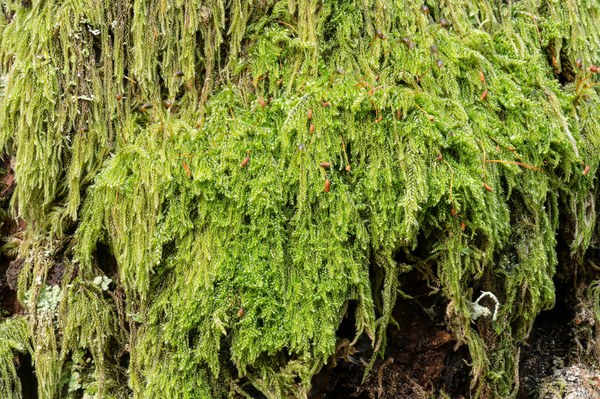 Coiled-leaf moss is small and a jeweler's loupe is needed to see the details of each strand and the beauty of the clump.
Coiled-leaf moss is small and a jeweler's loupe is needed to see the details of each strand and the beauty of the clump.
Naming plants and animals has always been important to me. Robin Wall Kimmerer, the poet and scientist, might have said it best. "It's a sign of respect and connection to learn the name of someone else, a sign of disrespect to ignore it... Learning the names of plants and animals is a powerful act of support for them. When we learn their names and their gifts, it opens the door to reciprocity." I feel that naming things provides a level of dignity, recognizing something as distinct from other living organisms. Seeing those details in nature creates a desire to find more and an anticipation for what might be around the next corner. Back in January, it was so fun to see the reactions of participants when I’d show them the details of mosses and lichens with the aid of a jeweler’s loupe. Those minute discoveries were so different from this owl, yet equally fascinating.
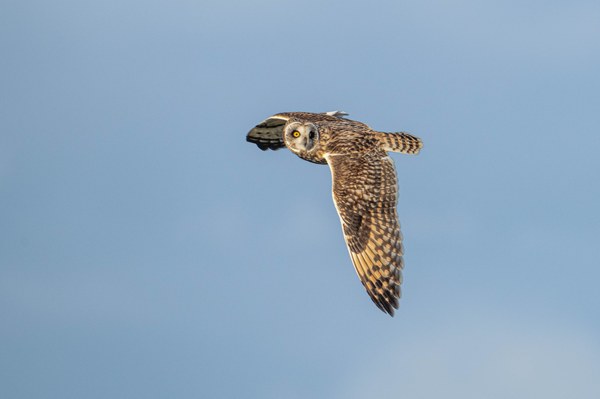 The Short-eared Owl continued to work the marsh, flying zig zags along its path, looking for possible food.
The Short-eared Owl continued to work the marsh, flying zig zags along its path, looking for possible food.
The owl flapped slowly, moving one way and then another, making a zigzag along her flight plan. She'd come much closer, within a hundred yards. I really didn't know her sex, but her movements, grace, and style gave me that thought. Her head pointed left, right, down, as her ears tuned to anything that might be a mouse or vole in the thick grass. Her yellow eyes almost glowed when she looked my way — the white outline of the facial disk forming a round heart shape. Her black pupils, yellow irises, and dark brown "mascara" that circled her eyes made her face pop in beauty.
At one point, those yellow eyes seemed to be glued right on me as if she was considering me for an afternoon meal. Fortunately, she quickly looked away, continuing her quartering.
These short-eared owls are here by themselves. They only pair up for the nesting season and must compete with other owls and harriers for food. Perhaps, they, too, have a sense of isolation during this time of year. During this year of COVID, I've spent more time watching birds out my windows, reading about others' trips into wild country, and dreaming about the possibilities instead of seeing things firsthand in the wild. It hasn't been easy.
John interrupted my thoughts when he asked, "Do you think we will be able to carpool once we have our second shots?"
"Not until everyone is vaccinated, I suspect. There is still a chance we can spread the virus," Donna said.
"I'm not expecting to be vaccinated before late summer," Danielle was watching the owl fly low over the grass.
Three of us had gotten our first shot, but Danielle wasn't eligible yet. Here was another dilemma to consider: keeping people safe as some become vaccinated and others not. The owl continued to quarter just a little way away, and I thought we must make these field trips work for all.
Those long wings seemed to extend far out from the owl's body. The downward flaps, although appearing slow, propelled her along. The lighter inner parts of her primaries glistened in the sun, while the darker brown of the covert feathers and secondaries showed the intricate details of her plumage. That mottling allows her to blend into the grass, disappearing when she lands.
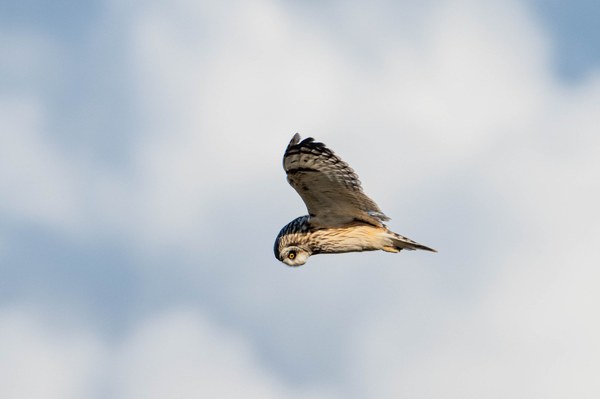 These owls are capable of hovering in space as they use their disk-shaped face to detect any sounds in the vegetation that might be a prey item.
These owls are capable of hovering in space as they use their disk-shaped face to detect any sounds in the vegetation that might be a prey item.
Her movements seemed like a mixture of a ballerina and a gymnast. At one point she folded those wings, extended her feet, and dropped like a bullet to the ground, coming back up within a few seconds - no mouse there. At another, she landed on part of a dead stump, sitting like an Olympian on the podium. Her head twisted one way and then another as she continued to scan the wetland for sounds that might indicate prey. I rubbed my neck in response to the distance she could twist her head; it seemed close to 360 degrees. Then with hardly a twitch, she was back in the air.
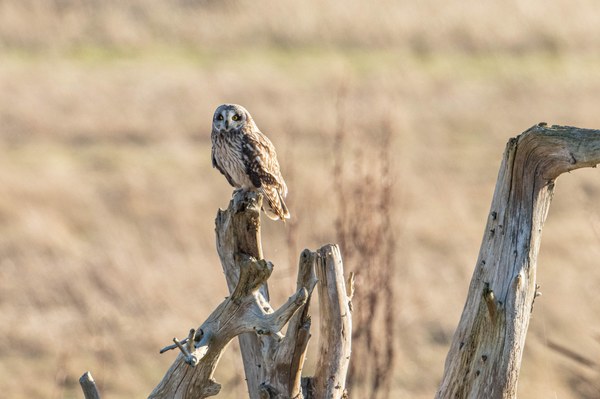 the owl on a stump, searching the marsh for possible prey.
the owl on a stump, searching the marsh for possible prey.
Soon she hovered about a hundred yards down the dike. She rotated her wings to create both frontward and backward lift, keeping her body stationary just twenty feet above the grass as her face looked straight down. Perhaps a vole was scurrying through the tangle. Suddenly, she stopped flapping and dropped half the distance before picking her flight back up, moving out over the marsh. We stood, hoping she might ignore us and come right along the dike, flying close by, but no, she circled out and around us before coming back along the embankment on our opposite side.
"Magical," said Danielle. We'd been mesmerized by this owl for over an hour. Her acrobatic dance had been enchanting, like something from a fairy tale. Her large wings for her weight give her a low loading, making her flight agile, graceful, appearing almost effortless. As she drifted farther away, we looked at each other without a word, nodded slightly, and turned to head for the cars which would take each of us back to our own isolation.
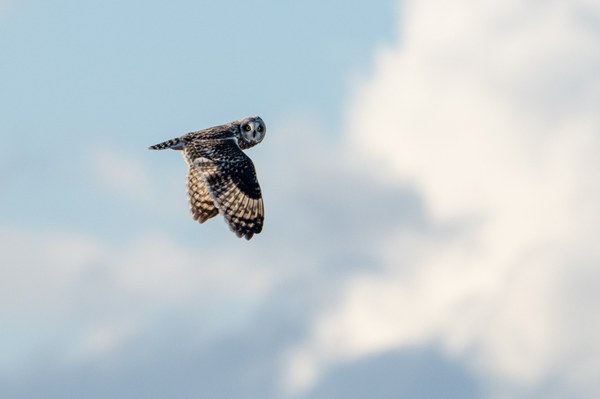 The short-eared owl made a loop out from where we stood and continued her hunting.
The short-eared owl made a loop out from where we stood and continued her hunting.
Lead image of a Short-eared Owl flying low over the marshes along Skagit Bay. All photos by Thomas Bancroft unless otherwise indicated.
Add a comment
Log in to add comments.Beautiful, Tom.
Thanks, it was a great day to be out there with you and the others.
 Thomas Bancroft
Thomas Bancroft